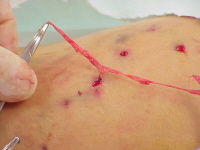What is ambulatory phlebectomy?

Ambulatory phlebectomy is a procedure to remove large superficial varicose veins through tiny incisions. An alternative to typical vein stripping surgery, this minimally invasive procedure can be used to remove the dilated veins in the legs which are both unsightly and uncomfortable for almost one third of adults. Varicose veins result from a variety of factors including prolonged standing, heredity, and pregnancy. While some varicose veins are asymptomatic, many result in swelling of the lower legs and feet, leg cramps, and occasionally a break down of the overlying skin called stasis ulcers. Treatment for varicose veins ranges from conservative, non-invasive approaches such as exercise and compression hose to surgical vein stripping under general anesthesia. Ambulatory phlebectomy is a minimally invasive procedure developed to remove the dilated veins through small incisions under local anesthesia. Due to the reduction in anesthesia and small incision size, these procedures can be performed in the physician’s office or in an outpatient surgery center.
What are the benefits of ambulatory phlebectomy over other procedures?
Ambulatory phlebectomy offers excellent cosmetic results treating large varicose veins. With the limited requirements for anesthesia, these procedures can be performed on an outpatient basis or even in the physician’s office. The reduced anesthesia increases the safety of the procedure and shortens the immediate recovery time, decreasing the possible post operative complications which occur with other vein treatment procedures. Ambulatory phlebectomy also offers the advantage of a decrease in the recurrence of the varicose veins in the early post operative period over procedures where occlusion is used.
How is ambulatory phlebectomy performed?
Ambulatory phlebectomy begins with the patient standing since this is the position where the varicose veins are most easily identified. The veins to be removed are marked with a surgical marker. Then with the patient supine, the leg is prepared with an antiseptic solution and local anesthetic is injected along the veins to be treated. A common anesthetic used with this procedure is a large volume of a low concentration local anesthetic. The fluid not only numbs the surrounding area for the ambulatory phlebectomy procedure, but it helps to pull the veins away from the adjacent tissue and compresses the surrounding capillaries to reduce post procedure bleeding.
Once the entire area to be treated has been injected with the anesthetic solution, tiny incisions are made over the veins, which can then be removed using vein hooks. The incisions for ambulatory phlebectomy procedures are so small they do not require sutures. These incisions allow the excess fluid to drain post operatively. When all the veins targeted for treatment on one leg have been completely removed, pads to absorb the fluid are placed next to the skin and the leg is wrapped tightly in a compression bandage.
What is the recovery process after ambulatory phlebectomy?
The compression bandage is an important part of ambulatory phlebectomy and must be worn for 24 to 48 hours. In addition, it is important for the patient to ambulate soon and often since the contraction of surrounding muscles help to rid the treated areas of excess fluid, reduce the risk of blood clots, and contribute to the healing process. Once the bandage is removed compression hose are worn for one to three weeks as the legs completely heal. With a minimally invasive ambulatory phlebectomy, most patients are back to work within 1 to 3 days. The only activities to be avoided in the first few weeks are prolonged standing and heavy lifting.
What are the risks associated with ambulatory phlebectomy?
Complications can occur with any procedure, the most common being bleeding or infection. With the small incisions used for ambulatory phlebectomy these complications are much less common than with traditional vein stripping. Typically the incisions heal without scarring. Darker skinned individuals may require more time for these areas to fade. Other post operative problems which typically resolve are discoloration of the surrounding skin, numbness, and tingling. With any treatment procedure long term recurrence of varicose veins can occur, especially if the same factors causing them remain following treatment.
Is the procedure approved for use in the U.S.?
Ambulatory phlebectomy is approved for the treatment of varicose veins in the United States. It is an accepted alternative to surgical vein stripping for appropriate patients. To find out if ambulatory phlebectomy is a treatment option, the patient must be evaluated by a physician experienced in the treatment of varicose veins. In many people who have varicose veins, a combination of procedures, requiring more than one treatment session must be used to remove all of the dilated veins and achieve the desired cosmetic result.
How much does the procedure cost?
The cost of an ambulatory phlebectomy depends on the extent of the varicose veins to be treated. Insurance often covers the cost of treatment but may require more conservative options such as compression hose, weight loss, and exercise be initiated first before surgical therapy is undertaken. Since each patient is different, consultation and evaluation by a physician experienced in ambulatory phlebectomy is the best way to determine if this procedure is appropriate.
